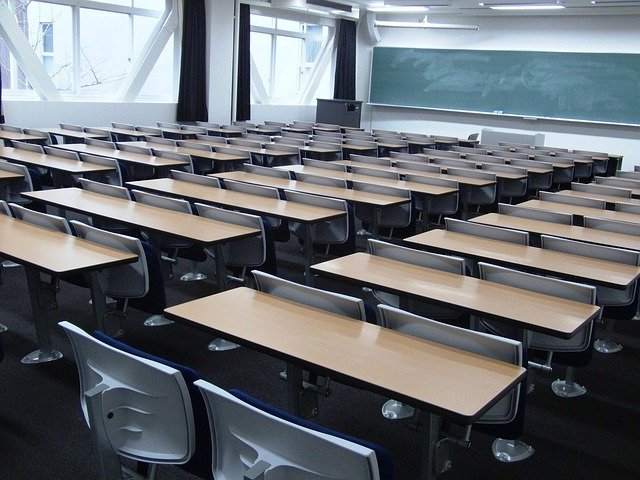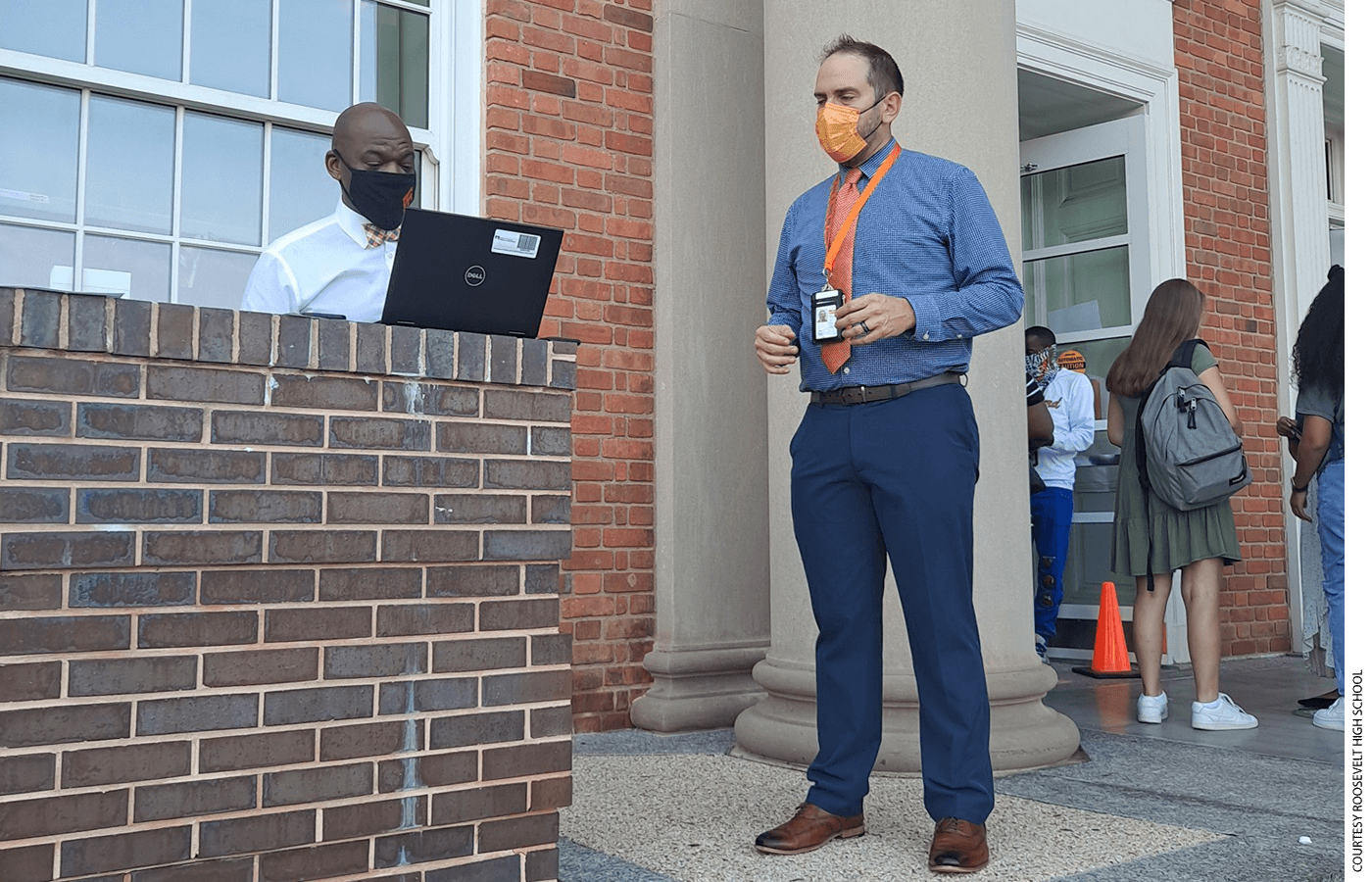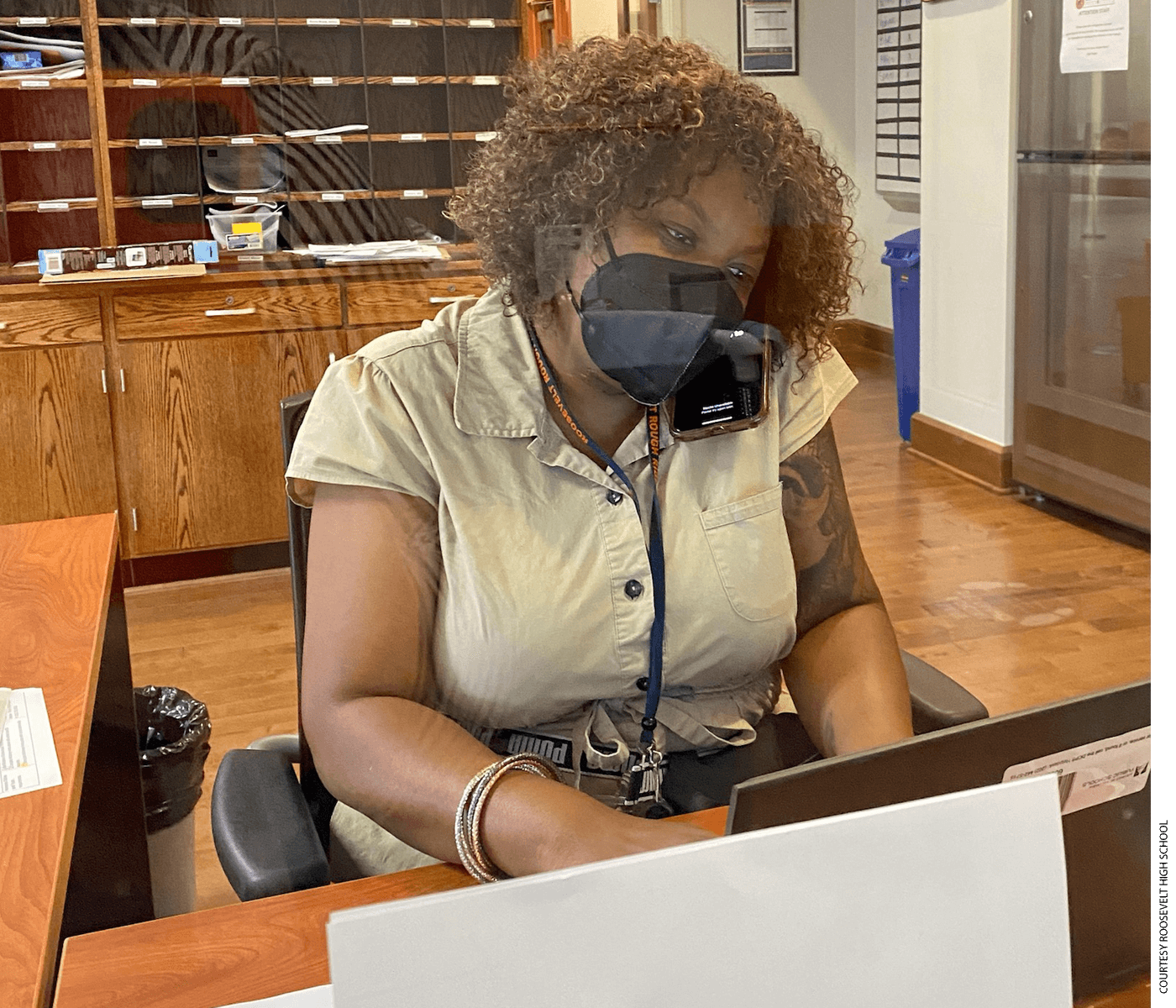
On a Wednesday evening in May, the personnel committee at the District of Columbia’s Roosevelt High School sifted through a batch of recent candidate applications, working to fill the school’s openings by June. The committee combined its own hiring requirements with a comprehensive, data-driven vetting system known as TeachDC, which was developed by D.C. Public Schools over the course of a decade.
The distinctive DCPS hiring system provides the leaders of the 116 schools in the district of more than 50,000 students with a pool of highly vetted teacher candidates but then lets the school leaders make the final hiring decisions for their schools.
Under the centralized TeachDC model, prospective teachers submit applications and answer questions through a common portal. The candidates then are interviewed by veteran DCPS teachers who have earned “effective” or “highly effective” ratings under the DCPS teacher-evaluation system. The most promising applicants are put into a “recommended pool” that is housed in a central database that principals can customize to their schools’ hiring needs. Principals and their hiring committees can draw from the pool or find their own candidates.
The DCPS hiring system has produced encouraging results. The district’s schools are receiving more applications from a more diverse pool of candidates. Ninety-eight percent of the district’s teaching vacancies were filled by the first day of school in the 2020–21 school year. Highly vetted applicants of the sort hired under the TeachDC program prove to be stronger teachers, research suggests.
DCPS allowed me to follow Roosevelt’s recruitment, selection, and hiring of teachers for the 2021–22 school year to understand the district’s systematic approach to staffing.
On this day in May, Roosevelt, a comprehensive high school in a rapidly gentrifying neighborhood, still needed a 9th-grade Algebra 1 teacher, two 10th-grade geometry teachers, an 11th-grade Algebra 2 teacher, and a teacher certified in both special education and math. A special-education teacher at the school, also certified in math, wanted to move into the Algebra 2 spot. The group agreed, which created a second special-education opening. The committee also decided to offer Algebra 1 and geometry positions to two people who had just completed their teacher training at Roosevelt as part of the Urban Teacher residency program, one of two national residency programs operating in the district, before diving into a discussion of the candidates interviewed that day.
Every year, before the hiring season begins, Principal Justin Ralston meets with the district staffing coordinator assigned to Roosevelt to project hiring needs for the coming school year. A central-office recruitment-team member assigned to the school stays in touch regularly and provides additional support for especially hard-to-fill openings. DCPS also shares resources with principals, such as exemplar hiring criteria, questions they can use during candidate interviews, and a hiring guide, as well as hiring webinars for all school leaders to share best practices. Roosevelt uses both TeachDC and a hiring tab on its own homepage to source job applicants. To identify vacancies early, DCPS pays a $1,000 bonus to teachers if they announce their departure by April 1.

Candidates who respond to the school’s homepage have not necessarily gone through the centralized screening process to make it into the recommended pool. But by filling out an interest form through the school’s website, they have shown a particular interest in Roosevelt, which the staff views as a plus. The school administration and personnel committee regularly scour both sites for potential candidates and reach out to conduct initial phone interviews, after which a candidate may be recommended for a more in-depth interview by the personnel committee.
The school keeps an internal tracker of all applicants and job openings. In his weekly email to staff, Ralston includes a spreadsheet of existing vacancies and the status of interviews and hiring. That helps to encourage staff members to find and refer potential candidates. “Word of mouth is incredibly powerful in education,” he says.
Roosevelt has its own robust screening and selection criteria, in addition to those used by TeachDC, to ensure prospective hires match its unique needs and culture. All candidates, including those recommended by the district, must submit performance tasks prior to their in-depth interview. For example, candidates may be asked to look at student data, extrapolate what it means, and design reteaching options or observe a lesson and analyze what went well and what didn’t. Ralston says Roosevelt designed the performance tasks to gather more evidence on candidates’ teaching practices. “We rely heavily on the performance tasks,” he says, which the school developed in partnership with Internationals Network, a network of schools and educators serving multilingual learners.
“We want to know how they think,” explains Begaeta Ahmic, a 9th-grade math teacher and the personnel committee chair. “Their responses give us a lot of insight before we even sit down to talk to them. And we give them time to talk about those tasks during the interview as well, especially if we have follow-up questions.”
Members of the personnel committee take turns leading the interview based on questions the team has developed. Those questions have evolved over time, but generally focus on identifying candidates who share three Roosevelt priorities: family engagement, including a passionate commitment to serving Roosevelt’s students and families; innovative teaching strategies for their subject; and value for Roosevelt’s school community, shown through collaborative thinking and a positive response to feedback.
During one interview for the job opening in special education and math, for example, interviewers asked the candidate to describe a specific time when he struggled to connect with a parent. They also asked him to describe an experience in which he collaborated with a team member and it didn’t go well. How did he handle those situations, and what did he learn?
Because Roosevelt is the only comprehensive high school in the district with a global-studies program, the interviewers also asked the candidate how he might use contemporary world issues to increase rigor in the classroom. A math teacher on the committee asked, “How would you help students understand that division by zero is undefined?” A special-education teacher asked how the candidate managed time to meet paperwork deadlines and instruction and how he collaborated with general-education teachers to benefit students.
Ahmic, who has been on the personnel committee for four years, asserts the importance of a good group of colleagues. “I really want to be part of deciding who will be at Roosevelt the following year,” she says. “It’s so amazing to me that teachers have such a loud voice in this process. It’s literally teachers making the call, and I think that transparency in hiring is pretty amazing. I know it’s not the case everywhere.” When the committee cannot reach consensus, they put it to a vote. Ralston walks every staff member—including the two assistant principals and director of operations—through the hiring process. Teachers have led the decisionmaking for all positions in the building, and he has never countered their choices.
During the hiring season, the personnel committee typically conducts interviews every Tuesday and Wednesday after school until six or seven in the evening. The interview season usually starts in April, with the goal of being fully staffed by June. “We do not want to be in a position where it’s August and we’re scrambling to fill positions,” says Ahmic, noting that the earlier they start the process, the more candidates they can interview “to really find somebody who would be a good fit for the school.” She adds, “If we’re hiring another Algebra 1 teacher, I want to work with that teacher over the summer to get to know each other and prepare ourselves for the upcoming school year.”

Filling all of its positions for 2021–22 was particularly challenging for Roosevelt. On top of the staffing challenges the Covid-19 pandemic has created for schools nationwide and normal staff turnover, the school lost several staff members who had provisional teaching licenses and did not earn their permanent licenses on time. In addition, it had to fill new job openings because the school’s student population is growing. Many of its openings were in shortage areas, such as special education and math, and there was also an opening for a school psychologist.
To help recruit candidates, Roosevelt uses social media such as Instagram and Twitter to showcase the school throughout the year. It holds its own open houses, advertised through word of mouth, for prospective teachers. This year, the district’s first virtual hiring fair also helped surface job candidates. After the hiring fair in April, 45 candidates completed “interest forms” on Roosevelt’s hiring web page. Stacy A. Fells, Roosevelt’s chief of school staff, is responsible for making sure job applicants feel supported, letting them know where they are in the application process and, once they are hired, helping them navigate the system’s onboarding process.
Diversity is a priority for Roosevelt, since half of its students are Black and the other half are Latino, pulled from across the city.
At the district level, DCPS has promoted diversity by pursuing partnerships with national organizations such as Teach For America, the Urban Teacher residency program, and Relay Graduate School of Education, which offers a teacher-residency program. All have track records of recruiting skilled and diverse teaching talent.
DCPS has also begun collaborating with local universities. It is partnering with Howard University to recruit teachers of color in science, technology, engineering, and mathematics. Through Howard’s teacher-residency program, participants earn a master of education degree in exchange for a three-year commitment to teach in DCPS. The residency program aims to recruit a cohort of at least 50 percent males per year and attract the majority of candidates from a range of disciplines and occupations. The district has also paired with American University and George Washington University to recruit educators to fill teaching and school-leadership vacancies and is working with Georgetown University to create a pipeline of dual-language educators, with an emphasis on developing local talent.
DCPS is addressing its diversity challenge from another direction, as well. Effective and highly effective teachers who interview job candidates go through an extensive training process with equity front and center to ensure that bias doesn’t creep into their interviews. To ensure high-needs schools like Roosevelt can attract and retain teaching talent, the district has a program known as Rigorous Instruction Supports Equity, or RISE. That program provides targeted support to 42 high-needs schools, including preferential access to district hiring fairs, hiring incentives to teachers in critical-shortage areas hired by July 1, mentoring support for novice educators, and opportunities for highly effective teachers in these schools to fill advanced instructional and leadership roles under the district’s career-ladder system.

Against the backdrop of the district’s efforts, Roosevelt has approached the diversity challenge in two ways. It benefits from DCPS’s partnership with Urban Teachers to help grow, develop, and cultivate its own in-house pool of teaching candidates. There were seven Urban Teacher residents at Roosevelt in the 2020–21 school year, the most of any school in the district.
Cesar Juarez, who teaches 11th- and 12th-grade math at Roosevelt and serves on the personnel committee, completed his Urban Teacher residency training at Roosevelt after graduating with an undergraduate degree in chemical engineering. “I was really blessed to be able to find a good fit right away,” he says. “I just wanted to be in a school community that has students that look like me. I’d never had a teacher who was Latino when I was growing up in Chicago.”
During his two years as a teacher resident, working alongside a high-performing mentor teacher, he was able to observe classrooms in multiple subjects, not just math. “I wanted to see what the Roosevelt student experience is like holistically from the moment they walk in until they walk across the graduation stage,” he recalls. “I really feel like I was learning so much from the school community.”
In addition to growing its own candidates through Urban Teachers, Roosevelt prioritizes hiring DCPS alumnae who grew up in the district—both because they are more familiar with the community and the historical challenges facing city residents and because they are less likely to leave. “We have been able to really expand our DCPS alumnae at Roosevelt over the last couple of years,” says Ralston, noting that 20 of his 132 staff members are products of DCPS.
By the end of June, Roosevelt had filled all but one of its teacher vacancies for the 2021–22 school year. Of its new hires, most came from TeachDC, including previous Urban Teacher residents at Roosevelt. Two others came through direct contacts Ralston had with a school where he once worked that was phasing out its middle school, and one teacher came through a recommendation by another staff member.
Over the next few years, school systems will receive a historic influx of funding to address fallout from the pandemic. A powerful way for districts to use those funds to improve student achievement, especially for low-income students and students of color, is to strengthen their teacher-recruitment, selection, and hiring practices. The District of Columbia Public Schools’ comprehensive, data-driven approach provides a strong example of what’s possible.
Adapted from the FutureEd report Right from the Start: D.C.’s Groundbreaking Teacher Hiring Strategy.
The post How D.C. Moved Teacher-Hiring Earlier and Used Data To Boost Quality and Diversity appeared first on Education Next.
[NDN/ccn/comedia Links]
News…. browse around here
No comments:
Post a Comment